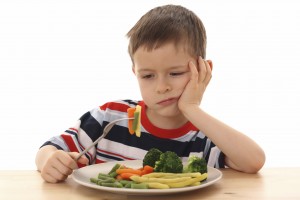
One of the biggest concerns parents have is getting their kids to eat well. Dealing with picky eaters is a huge challenge, and one that most parents will face at some point during childhood. Here are some tips to help you weather the tough times and your kids learn better eating habits.
First, relax. I promise, no neurologically normal child has ever starved to death with access to healthy foods. You will both get through this. Eventually.
“Picky eaters” fall into two broad categories: Kids who eat small amounts, and kids who eat few kinds of food. If you’re concerned that your child isn’t eating enough, talk to your pediatrician. Sometimes kids live on air. As long as they’re growing appropriately, there’s nothing wrong with letting them follow their appetite. (In fact, we recommend it.) Remember that small people have smaller caloric requirements. As a general rule of thumb, a child’s portion of carbs at a meal on average shouldn’t be bigger than her tight fist and a protein portion shouldn’t be larger or thicker than the palm of his hand. Over the course of a week, we want them to eat a “rainbow” of colors of fresh fruits and vegetables.
Kids who refuse to try new foods and eat very little variety are a bigger challenge, both for their parents and their pediatricians. You can’t and shouldn’t force a kid to eat, but you can employ strategies that over time will encourage healthier eating habits:
(1) If possible, make mealtimes a family affair. Get into the habit of having each person share one good or funny thing that happened that day. Focus on each other, not the food. Turn the TV off before everyone sits down to eat. (Make this a general practice even when kids are sitting down for snacks. Sit down at the table to eat, and no eating in front of the TV.) Let them see you eating a healthy variety of foods as well.
(2) Don’t let the kids know you care whether they eat or not. If they think they can get your goat over something, they will. Make the food available, and pretend it doesn’t matter to you if they eat.
(3) Rather than serving “family style,” plate the appropriate portions of the proteins and carbohydrates before you bring the food to the table. People who are still hungry after eating those portions can fill up on more non-starchy fruits and vegetables, which should always be on the table.
(5) If kids aren’t eating, don’t make them something different or let them fill up on less healthy snacks later. Kids who don’t eat dinner will probably be hungry at breakfast. Or the day after tomorrow. (An exception would be a child who’s generally a pretty healthy eater but can’t stand a particular meal. In that circumstance, a bowl of cereal is a reasonable substitute.)
(6) Avoid sweet drinks, including juice and sports drinks. Kids can fill up on the empty calories in them and not be hungry for meals.
(7) Do your best to ignore the whining (probably the hardest thing for all of us) and if it gets too bad, send the kids to their rooms (without TV or computers). Make it a family rule that no one gets to ruin dinner for everyone else just because they don’t like what’s on the table. (Adults, too!)








Leave a Reply